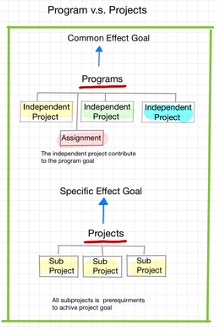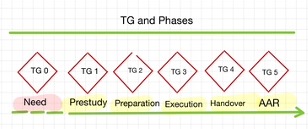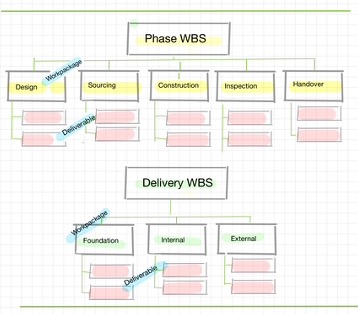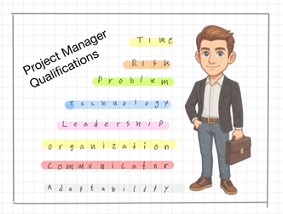Organizing Project & Program
Project and Program management are essential for organizations to remain competitive and operate efficiently. It provides a structured approach to managing activities, implementing changes, and driving improvements to ensure successful outcomes. The essence of project and program management lies in ensuring agreed-upon deliverables are completed on time and within budget, as well as achieving meaningful and sustainable results.
In most cases, project governance organizations are integrated into the line organization to safeguard competence and ensure effective project development. However, project structures and management approaches vary across industries and in some cases, projects may operate with considerable independence, while still retaining certain reporting obligations to the line organization.
Project or Program
What’s the Difference?

Project Management focuses on planning, executing, and completing specific tasks, for example building a bridge, within defined constraints such as time, cost, and scope. Large CAPEX related project normally consists of on sub-projects. The Project Manager coordinates teams, manages risks, and ensures that subprojects are aligned to meet the project’s objectives.
In contrast, Program Management involves overseeing multiple related projects to achieve strategic objectives, for example building a aircraft. These projects may be independent but still contribute to the overall program goals. The Program Manager aligns projects with program objectives, manages interdependencies, and ensures the program’s benefits are realized.
A program is an effective approach when an organization aims to achieve large-scale change, as the scope of a program can adapt without altering its objectives. On the other hand, project management is ideal when uncertainty is high, and tight coordination of sub-projects is essential to meet specific project objectives
Praxis and Flexibility
For many years, Project and Program Management followed rigid, process-driven frameworks to achieve results. Today, that landscape has shifted. Modern project management prioritizes agility, team empowerment and value delivery in a world that’s increasingly complex and fast-moving.
The rise of adaptable project management principles has paved the way for a standardized yet flexible approach, enabling organizations to tailor methodologies to fit their unique needs. As a result, project managers familiar with one framework can more easily transition across industries and business environments—delivering successful outcomes along the way. That said, some project domains require a deeper understanding of specific methodologies.
In development-focused projects, especially in software based development, the Agile Manifesto prevails. While developing project goals are typically well-defined, the path to achieving them often evolves as the project progresses. In this context, Agile embraces an iterative approach, allowing teams to continually refine their direction based on real-time feedback and project progress. In contrasts with infrastructure projects—such as building construction, roadwork, or manufacturing—which typically follow a more rigid, step-by-step approach, are not immune to change and can benefit from flexible planning and adaptive execution strategies.
In practice, this means that modern projects often combine traditional project management methodologies with the Agile approach, and it is the nature of the project deliverables that influences the choice of best practices.
Project Preparation

As with all human activities, preparation is crucial for success. The same principle applies to project and program management. The fundamental rationale for a project is often articulated by the line organization in the Project Assignment, which tasks the Project Management Office (PMO) with leading a project initiative in order to achieve an Objective (impact goal).
To understand a project’s purpose and establish goals that support its Objectives, the project team typically engages in dialogue—both internally and with the line organization. These discussions help clarify the rationale, purpose, and constraints of the emerging project, and explore alternative approaches that align with the line organization’s Objectives.
The preparation phase generally centers on four key themes: the Need to be addressed, the Expected Results, the Project Scope, and the Execution Plan. These elements are closely interconnected and must be considered together to ensure a successful project outcome.
Project Process
As the need to establish a project often emerges based on a reqirement from the line organisation, the PMO to initiate a Prestudy. This Prestudy validates the viability of establishing a project. When a decision is made to investigate or initiate a project, deeper analysis and pre-work are necessary to understand the expected project deliverables—along with clarifying what the project will not deliver. This process typically occurs during the Pre-study and/or Preparation phase. The focus is on setting the ambition level and direction for the project, often through an iterative process involving the project team and stakeholders.
 Following the Pre-study phase, the Preparation phase involves the project team working to refine the project’s objectives in greater detail. During this phase, the project is organized and structured, and a visual map of the project’s deliverables is created to ensure proper coordination. This phase also includes resource planning, budget estimations, and risk mitigation measures. Sometimes, a make-or-buy decision is made in this phase, meaning procurement activities may be planned at this stage.
Following the Pre-study phase, the Preparation phase involves the project team working to refine the project’s objectives in greater detail. During this phase, the project is organized and structured, and a visual map of the project’s deliverables is created to ensure proper coordination. This phase also includes resource planning, budget estimations, and risk mitigation measures. Sometimes, a make-or-buy decision is made in this phase, meaning procurement activities may be planned at this stage.
In the Execution phase, the project team works to ensure that sub-projects are coordinated and aligned with the overall project objectives. Progress reporting to steering groups and stakeholders is crucial for communicating performance and managing risks, ensuring that the project meets its objectives. If external suppliers are involved, the project team must ensure their contributions align with the project goals.
Additionally, if the project involves Change Management, the team must ensure that change activities are communicated and are effectively carried out, and if needed including necessary training or competence development are secured.
Once project deliverables are secured and approved according to the Project Assignment, the Hand-Over phase is initiated. This phase involves documenting lessons learned and handing over all necessary documentation to the line organization.
Project Techniques
Regardless of the type of project or program, it is always important to clearly communicate what the project is about. This helps others understand the purpose and goals, and allows them to contribute valuable insights. Tools such as user stories, prototypes, models, and pictures can effectively illustrate the project’s vision and expected outcomes.
When it comes to organizing a project or program, the Work Breakdown Structure (WBS) is a widely used technique. A WBS breaks down the overall project deliverables into smaller, manageable work packages. This structure not only simplifies the complexity of large projects but also helps visualize how different deliverables are connected. It supports budget forecasting, resource planning, and scheduling to ensure alignment with Tollgate milestones.
Depending on the nature of the project, the WBS can be structured in different ways:

-
A Functional or Deliverable Breakdown focuses on the end product and shows how different components contribute to achieving the project’s objectives.
-
A Phase-Based Breakdown organizes work according to the sequence of events or project phases, often aligned with tollgate reviews.
A WBS can also be used to break down a project into specific scopes of activities that need to be carried out in order to perform the work required for the project.
Agile
The Agile methodology, unlike traditional methods that plan and deliver everything more or less by a step-by-step approach, Agile projects are iterative and adaptive. Work is done in short cycles called sprints (typically 1–4 weeks), with continuous feedback from stakeholders, especially end users. This approach allows the product to evolve over time based on actual needs, reducing the risk of major surprises at the end of the project. Although traditional project methodologies do manage risk, they primarily do so through continuous risk assessments.
A key benefit of Agile is that it encourages early and frequent delivery of usable components, making it easier to adapt to changes and better meet project objectives as they evolve. Naturally, it also demands deeper engagement and more time spend with the end-user. Nevertheless, the Agile methodology is more appropriate for development projects, however, some element of Agile could be incorporated WBS projects in order to monitor deliveries and some Agile project could benefits from a more structure approach in order to manage budgets. Agile methodologies can also be integrated into traditional project management approaches to help solve problems more effectively.
While WBS-based (traditional) projects are predictive—with detailed planning done upfront, risk managed as you go along—Agile projects are adaptive, allowing teams to adjust plans early as they go. Despite their differences, both approaches share common elements:
- A structured breakdown of work
- A strong focus on delivering value
- Clear scope definition per phase or sprint
- Progress tracking against a defined plan
Project Manager Qualities
The nature and scope of projects can vary widely—from small-scale tasks to multi-billion-dollar initiatives spanning several years. Regardless of size or complexity, organizations increasingly recognize that training plays a vital role in ensuring high-quality project delivery. To be successful, a project manager must therefore possess a diverse set of skills.

An effective project manager possesses a blend of essential qualities that enable successful project delivery. Strong Leadership is crucial, as it helps guide the team with vision, motivation, and clarity. Building and maintaining a strong team culture is important, which involves fostering collaboration, trust, and mutual support.
Excellent Communication skills ensure that ideas, expectations, and feedback are clearly conveyed to all stakeholders. Organizational skills play a vital role in keeping tasks, timelines, and resources on track. Additionally, a good project manager must have solid Problem-solving abilities to quickly address challenges and implement effective solutions.
Adaptability is another key trait, allowing the manager to respond flexibly to changes and adjust plans as needed. Time Management is essential for prioritizing tasks and meeting deadlines consistently. A project mana
ger should alsobe proficient in Risk Management, identifying potential issues early and developing contingency plans in order to stay focused.
Furthermore, sound decision-making skills enable the project manager to make informed, confident choices that drive project progress. Lastly, having a good level of Technical Proficiency helps the project manager understand the tools, platforms and technologies relevant to the work. Together, these qualities form the foundation of effective project management. Consequently, education has become a key factor in establishing standards and elevating the professionalism of project managers.
To promote excellence in the field, several project management institutions have emerged. One of the oldest and most recognized is the International Project Management Association (IPMA), which is dedicated to advancing professionalism and excellence in project management worldwide.